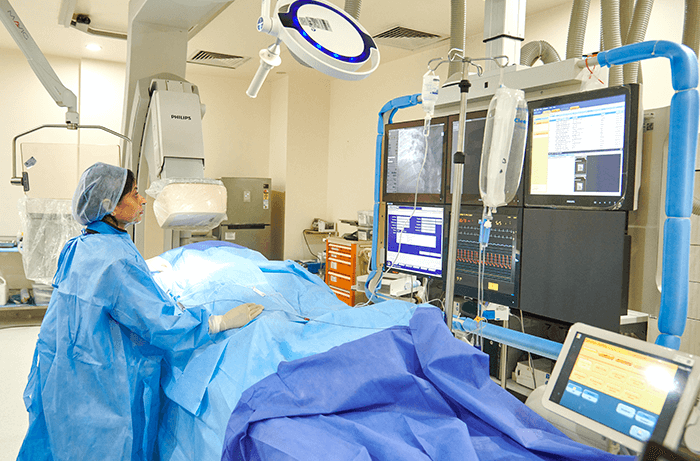×
Select Your Country
 International
International

×
Select Your Country
 International
International


Introduced by H Bentall and A De Bono in 1968, the Bentall procedure is a cardiac procedure performed for replacing or repairing an aortic valve, ascending aortic root lesion or aortic root. It involves the replacement of the aortic root and aortic valve with a composite aortic valve graft and ascending aortic graft which is later linked to the coronary arteries by anastomosis.
Why is it recommended?
The Bentall procedure is a gold standard intervention usually recommended for patients diagnosed with root and ascending aortic aneurysm associated with aortic valve regurgitation. It is also recommended for patients diagnosed with aortic dissection, which is a serious condition in which the inner layer of the aorta tears.
How is it performed?
Since its introduction in 1968, the Bentall procedure has been altered a couple of times to improve its effectiveness. The original procedure involved the use of a composite mechanical valve conduit. However, the entire diseased aorta was not removed and the coronary buttons were not made which made the procedure very complicated. Thus, the procedure was modified for making the coronary buttons and removing the entire diseased ascending aortic tissue. The new procedure involves the removal of a full-thickness “button” of the aorta surrounding the coronary Ostia for maintaining circulation in the coronary artery. This process makes the implantation of the proximal end of the coronary arteries into the openings made in the aortic vascular graft possible. It can be achieved by utilizing a mechanical prosthetic graft in which case, the anticoagulants have to be taken for the entire life. It can also be done by using a biological composite graft in which case a biological valve is utilized and anticoagulants can be stopped after 3 months. After that, only antiplatelets are recommended for the patient.
The following steps are followed during a modified Bentall procedure:-
The procedure involves the administration of general anaesthesia.
A median sternotomy approach is adopted for reaching the heart and aorta.
It employs the use of cardiopulmonary bypass.
Cross-clamping of the ascending aorta is done.
The aneurysm is opened and the blood cardioplegia solution is delivered for ensuring myocardial protection. This is done for mitigating the chances of reperfusion injuries that may occur after the aortic cross-clamp is removed.
The native aortic valve is then examined, separated from the surrounding tissue, and removed.
The right, as well as the left coronary ostium, is identified, after which, the buttons are made and left suspended.
The remaining aortic root is removed and a new aortic root prosthesis is implanted.
The re-implantation of the coronary ostium into the aortic root is done.
The heart is then de-aired, which is followed by the removal of the coronary cross-clamp.
Types of Aortic Root Substitutes:
The freestyle bioprosthesis is a porcine aortic root that is joined to the coronary arteries.
Composite mechanical valve conduit.
The Valsalva graft is a prefabricated biological aortic valved conduit. It consists of a triple-layered vascular graft and a porcine stentless biological valve.
What are the Advantages of Bentall Procedure?
The biological valve prostheses used in this procedure are more durable and superior.
The use of biological prostheses eliminates the requirement for blood thinners.
Risks of the Procedure
Low cardiac output
Diffuse cerebral hypoxia
External or internal bleeding
Renal failure that may require hemodialysis
Blood clot in legs or lungs
Cardiac issues like heart attacks and strokes
Death
Arrhythmias (abnormal heartbeat)
Short term memory problems like the blurring of vision and difficulty in concentrating.
Lung problems
Infection (sepsis and incision site infection amongst others)
What to Expect from the Procedure?
This procedure is performed for treating a larger ascending aorta aneurysm, which if left untreated, may burst and lead to adverse outcomes. Besides, it is also performed in cases where the aneurysm has already ruptured (emergency conditions). During this procedure, an incision is made in the middle of the chest for accessing the aorta. The heart is stopped for some time and a heart-lung bypass machine is used. The faulty valves and the defective part of the aorta are removed. After this, a synthetic graft, which is attached to a bio-prosthetic valve, is stitched with the aorta, which is followed by the attachment of the coronary arteries to the two openings made in the artificial graft. The incision is then closed and dressed. The entire procedure may last for nearly 5 hours. Apart from providing relief from aorta problems for a long time, the procedure also offers a high survival rate.
The entire Bentall procedure gets completed in around 5 hours.
In the original procedure, a composite mechanical valve conduit was used but the entire diseased aorta was not removed and coronary buttons were not made which made it highly complicated. Hence, the procedure was altered to remove the diseased ascending aortic tissue and make the coronary buttons. In the new procedure, a full-thickness “button” of the aorta surrounding the coronary Ostia is removed for maintaining circulation in the coronary artery, which makes the implantation of the proximal end of the coronary arteries into the openings made in the aortic vascular graft easier. It can be performed by utilizing a mechanical prosthetic graft in which case, anticoagulants need to be taken for the rest of the life or it can be performed by utilizing a biological composite graft in which case, a biological valve is used and anticoagulants can be stopped after a period of 3 months, after which, only antiplatelets are given to the patient.